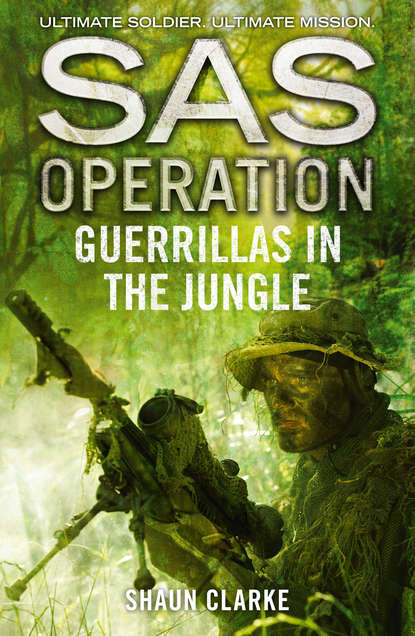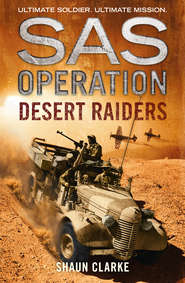По всем вопросам обращайтесь на: info@litportal.ru
(©) 2003-2024.
✖
Guerrillas in the Jungle
Автор
Год написания книги
2019
Настройки чтения
Размер шрифта
Высота строк
Поля
Guerrillas in the Jungle
Shaun Clarke
Ultimate soldier. Ultimate mission. But will the SAS patrol escape the deadly Malayan jungle alive?Malaya in the 1950s, and Communist terrorists wage a bloody war against the country’s estates and rubber plantation owners. Chased into the interior by British Army units, the guerrillas soon became experts at survival and evasion, emerging from the jungle only to launch increasingly ferocious attacks.On the recommendation of Lieutenant-Colonel ‘Mad’ Mike Calvert, veteran of Burma’s Chindit campaigns, 22 SAS is formed as a special counter-insurgency force. Three years later they begin their jungle patrols, learning how to survive for weeks at a time in hostile terrain, often waist-deep in water, and under attack from wild animals, leeches and poisonous insects.This extraordinary campaign climaxes in a nightmarish two weeks in the Telok Anson swamp tracking the troops of the notorious ‘Baby Killer’, Ah Hoi. What the regiment experiences in the Malayan jungle is both dreadful and unforgettable and will lay the foundations for the SAS’s legendary survival skills…
Guerrillas in the Jungle
SHAUN CLARKE
Published by HarperCollinsPublishers Ltd
1 London Bridge Street
London SE1 9GF
www.harpercollins.co.uk (http://www.harpercollins.co.uk)
First published in Great Britain by 22 Books/Bloomsbury Publishing plc 1993
Copyright © Bloomsbury Publishing plc 1993
Cover layout design © HarperCollinsPublishers Ltd 2016
Cover photographs © MILpictures/Tom Weber/Getty Images (soldier); Shutterstock.com (textures)
Shaun Clarke asserts the moral right to be identified as the author of this work.
A catalogue copy of this book is available from the British Library.
This novel is entirely a work of fiction. The names, characters and incidents portrayed in it are the work of the author’s imagination. Any resemblance to actual persons, living or dead, events or localities is entirely coincidental.
All rights reserved under International and Pan-American Copyright Conventions. By payment of the required fees, you have been granted the non-exclusive, non-transferable right to access and read the text of this e-book on screen. No part of this text may be reproduced, transmitted, down-loaded, decompiled, reverse engineered, or stored in or introduced into any information storage and retrieval system, in any form or by any means, whether electronic or mechanical, now known or hereinafter invented, without the express written permission of HarperCollins.
Source ISBN: 9780008154974
Ebook Edition © November 2015 ISBN: 9780008154981
Version: 2015-10-15
Contents
Cover (#ucc68f8a8-c1fb-5249-b0a3-e60e18e01a5d)
Title Page (#u4e3a7271-816c-55fa-8c7a-a310edc3207b)
Copyright (#uf101bcf6-b5a4-5f16-8214-31ba34e67cc1)
Prelude (#u0a65e149-54b9-52c4-90f8-9ad1a9d1240f)
Chapter 1 (#udf6cd976-4113-5731-8b2f-75d2cd309cd0)
Chapter 2 (#uc5ebb450-a8d5-55f9-bf07-5d55dbdb954c)
Chapter 3 (#u27f3b5cc-d1b4-5c17-9249-2e72e8836447)
Chapter 4 (#u43f1003e-c914-5c79-b9fc-024a25425e25)
Chapter 5 (#litres_trial_promo)
Chapter 6 (#litres_trial_promo)
Chapter 7 (#litres_trial_promo)
Chapter 8 (#litres_trial_promo)
Chapter 9 (#litres_trial_promo)
Chapter 10 (#litres_trial_promo)
Chapter 11 (#litres_trial_promo)
Chapter 12 (#litres_trial_promo)
Chapter 13 (#litres_trial_promo)
Chapter 14 (#litres_trial_promo)
Chapter 15 (#litres_trial_promo)
Chapter 16 (#litres_trial_promo)
OTHER TITLES IN THE SAS OPERATION SERIES (#litres_trial_promo)
About the Publisher (#litres_trial_promo)
Prelude (#u3da40d3c-4cac-5073-a631-6a0ae6f16645)
The guerrilla camp had been hacked out of the dense jungle and could be seen only from the air. Its centrepiece was a roughly levelled parade ground, about the size of a tennis court, though such a game was unknown to these people. Built in the natural caverns of red and ochre rock camouflaged by the overhanging foliage, the camp quarters consisted of a lean-to thatched with atap palm, with kitchen, lecture room, and sleeping benches for about sixty newcomers. The older hands were housed in an atap further up the hill, above the boulder and overlooking the parade ground.
A babbling stream, providing water for the camp, snaked around the boulder, past the parade ground and back into the dense, steaming jungle. The latrines were built further away, near to where the stream entered the jungle, carrying the excrement and urine to the isolated dwellings that used the same water for washing and drinking. The latrines themselves consisted of a thatched lean-to over a pit full of seething maggots. The stench was atrocious.
Few of the guerrillas were more than twenty-five years of age, most were under twenty, and a surprising number were little more than children. Some of the males wore khaki shorts, shirts and military caps, but most wore no item of uniform and were either dressed like coolies or wearing white shirts, grey trousers and felt hats. Most of them were barefoot, though some wore terumpas – wooden clogs held on by rubber straps.
Almost without exception, the women were in long-sleeved, high-necked white smocks and wide black trousers. All had bobbed hair and used no make-up. The better-educated taught Mandarin and singing; the others worked in the kitchen and did their fair share of the dirtiest, heaviest male chores. Though all of them acted as nurses, seamstresses and general domestics, they expected to be treated just like the men and could be just as merciless when it came to the treatment of prisoners or traitors.
The daily schedule was strict and demanding. Reveille was at first light, 5.30 in the morning, when the crying of gibbons and the clicking of cicadas dominated the chatter of the jungle. At 6.00, when the guerrillas had bathed and brushed their teeth, they took part in the flag-raising ceremony, singing ‘The Red Flag’. Roll-call was followed by a communal reading of the laws and regulations of the Malayan Races’ Liberation Army (MRLA). Calisthenics lasted until 6.30, followed by a cup of tea and a rest period.
At 7.00 they started drilling with weapons. This included practice in jungle-warfare tactics, racing up and down hills, climbing trees and learning various jungle ambush positions. At 8.30 they washed and rested, then had a breakfast of boiled tapioca or rice with greens – fern tops or sweet-potato leaves – followed by a second rest period.
Classes began at 10.00 sharp, with political and military lessons on a daily alternating basis, the former covering Marxism–Leninism, the writings of Mao Tse-tung and the current international situation; the latter, map-reading, tactical theory, lessons in the tactics of the Russian and Chinese armies, and the general principles of guerrilla warfare.
Shaun Clarke
Ultimate soldier. Ultimate mission. But will the SAS patrol escape the deadly Malayan jungle alive?Malaya in the 1950s, and Communist terrorists wage a bloody war against the country’s estates and rubber plantation owners. Chased into the interior by British Army units, the guerrillas soon became experts at survival and evasion, emerging from the jungle only to launch increasingly ferocious attacks.On the recommendation of Lieutenant-Colonel ‘Mad’ Mike Calvert, veteran of Burma’s Chindit campaigns, 22 SAS is formed as a special counter-insurgency force. Three years later they begin their jungle patrols, learning how to survive for weeks at a time in hostile terrain, often waist-deep in water, and under attack from wild animals, leeches and poisonous insects.This extraordinary campaign climaxes in a nightmarish two weeks in the Telok Anson swamp tracking the troops of the notorious ‘Baby Killer’, Ah Hoi. What the regiment experiences in the Malayan jungle is both dreadful and unforgettable and will lay the foundations for the SAS’s legendary survival skills…
Guerrillas in the Jungle
SHAUN CLARKE
Published by HarperCollinsPublishers Ltd
1 London Bridge Street
London SE1 9GF
www.harpercollins.co.uk (http://www.harpercollins.co.uk)
First published in Great Britain by 22 Books/Bloomsbury Publishing plc 1993
Copyright © Bloomsbury Publishing plc 1993
Cover layout design © HarperCollinsPublishers Ltd 2016
Cover photographs © MILpictures/Tom Weber/Getty Images (soldier); Shutterstock.com (textures)
Shaun Clarke asserts the moral right to be identified as the author of this work.
A catalogue copy of this book is available from the British Library.
This novel is entirely a work of fiction. The names, characters and incidents portrayed in it are the work of the author’s imagination. Any resemblance to actual persons, living or dead, events or localities is entirely coincidental.
All rights reserved under International and Pan-American Copyright Conventions. By payment of the required fees, you have been granted the non-exclusive, non-transferable right to access and read the text of this e-book on screen. No part of this text may be reproduced, transmitted, down-loaded, decompiled, reverse engineered, or stored in or introduced into any information storage and retrieval system, in any form or by any means, whether electronic or mechanical, now known or hereinafter invented, without the express written permission of HarperCollins.
Source ISBN: 9780008154974
Ebook Edition © November 2015 ISBN: 9780008154981
Version: 2015-10-15
Contents
Cover (#ucc68f8a8-c1fb-5249-b0a3-e60e18e01a5d)
Title Page (#u4e3a7271-816c-55fa-8c7a-a310edc3207b)
Copyright (#uf101bcf6-b5a4-5f16-8214-31ba34e67cc1)
Prelude (#u0a65e149-54b9-52c4-90f8-9ad1a9d1240f)
Chapter 1 (#udf6cd976-4113-5731-8b2f-75d2cd309cd0)
Chapter 2 (#uc5ebb450-a8d5-55f9-bf07-5d55dbdb954c)
Chapter 3 (#u27f3b5cc-d1b4-5c17-9249-2e72e8836447)
Chapter 4 (#u43f1003e-c914-5c79-b9fc-024a25425e25)
Chapter 5 (#litres_trial_promo)
Chapter 6 (#litres_trial_promo)
Chapter 7 (#litres_trial_promo)
Chapter 8 (#litres_trial_promo)
Chapter 9 (#litres_trial_promo)
Chapter 10 (#litres_trial_promo)
Chapter 11 (#litres_trial_promo)
Chapter 12 (#litres_trial_promo)
Chapter 13 (#litres_trial_promo)
Chapter 14 (#litres_trial_promo)
Chapter 15 (#litres_trial_promo)
Chapter 16 (#litres_trial_promo)
OTHER TITLES IN THE SAS OPERATION SERIES (#litres_trial_promo)
About the Publisher (#litres_trial_promo)
Prelude (#u3da40d3c-4cac-5073-a631-6a0ae6f16645)
The guerrilla camp had been hacked out of the dense jungle and could be seen only from the air. Its centrepiece was a roughly levelled parade ground, about the size of a tennis court, though such a game was unknown to these people. Built in the natural caverns of red and ochre rock camouflaged by the overhanging foliage, the camp quarters consisted of a lean-to thatched with atap palm, with kitchen, lecture room, and sleeping benches for about sixty newcomers. The older hands were housed in an atap further up the hill, above the boulder and overlooking the parade ground.
A babbling stream, providing water for the camp, snaked around the boulder, past the parade ground and back into the dense, steaming jungle. The latrines were built further away, near to where the stream entered the jungle, carrying the excrement and urine to the isolated dwellings that used the same water for washing and drinking. The latrines themselves consisted of a thatched lean-to over a pit full of seething maggots. The stench was atrocious.
Few of the guerrillas were more than twenty-five years of age, most were under twenty, and a surprising number were little more than children. Some of the males wore khaki shorts, shirts and military caps, but most wore no item of uniform and were either dressed like coolies or wearing white shirts, grey trousers and felt hats. Most of them were barefoot, though some wore terumpas – wooden clogs held on by rubber straps.
Almost without exception, the women were in long-sleeved, high-necked white smocks and wide black trousers. All had bobbed hair and used no make-up. The better-educated taught Mandarin and singing; the others worked in the kitchen and did their fair share of the dirtiest, heaviest male chores. Though all of them acted as nurses, seamstresses and general domestics, they expected to be treated just like the men and could be just as merciless when it came to the treatment of prisoners or traitors.
The daily schedule was strict and demanding. Reveille was at first light, 5.30 in the morning, when the crying of gibbons and the clicking of cicadas dominated the chatter of the jungle. At 6.00, when the guerrillas had bathed and brushed their teeth, they took part in the flag-raising ceremony, singing ‘The Red Flag’. Roll-call was followed by a communal reading of the laws and regulations of the Malayan Races’ Liberation Army (MRLA). Calisthenics lasted until 6.30, followed by a cup of tea and a rest period.
At 7.00 they started drilling with weapons. This included practice in jungle-warfare tactics, racing up and down hills, climbing trees and learning various jungle ambush positions. At 8.30 they washed and rested, then had a breakfast of boiled tapioca or rice with greens – fern tops or sweet-potato leaves – followed by a second rest period.
Classes began at 10.00 sharp, with political and military lessons on a daily alternating basis, the former covering Marxism–Leninism, the writings of Mao Tse-tung and the current international situation; the latter, map-reading, tactical theory, lessons in the tactics of the Russian and Chinese armies, and the general principles of guerrilla warfare.











